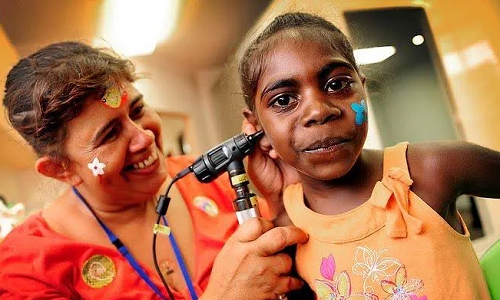Dangerous Listening
Many Indigenous people are exposed to loud noise for long periods in their home environments.
Crowded housing, the high proportion of Indigenous people with conductive hearing loss and easier access to noise-generating entertainment equipment appear to result in an extreme noise exposure profile in many Indigenous households.
Mostly, adults have bad ears because they had lots of ear infections when they were young kids. These infections damaged their ears. But now, too many Indigenous people are getting bad ears because of too much loud noise.
A research project funded by the Commonwealth Department of Health seeks to better understand the noise exposure risks in many Indigenous lifestyles. The investigation is being undertaken by Damien Howard, Lyn Fasoli, Stuart McLaren and Alison Wunungmurra.
The preliminary findings are cause for serious concern. While it is generally thought that domestic noise does not result in exposure to excessive noise, except perhaps in the case of some teenagers using personal amplification devices, the results show that many Indigenous people are exposed to loud noise for long periods in their home environments. Crowded housing, the high proportion of Indigenous people with conductive hearing loss and easier access to noise-generating entertainment equipment appear to result in an extreme noise exposure profile in many Indigenous households.
In addition, high levels of unemployment and low school attendance rates also mean that many Indigenous people will often spend a considerable amount of time in and around the home.
The research indicates that there is excessive noise exposure among quite young Indigenous children. They may, as a result, experience permanent hearing loss in early adulthood. It will affect them for the rest of their lives. Hearing loss experienced during the years when most people make the most productive contribution to their family and community (through involvement in work and child rearing) usually has a greater impact on the individual and their community than does later onset hearing loss.
In addition to the risk of hearing loss, exposure to excessive noise can have other adverse outcomes.
- Children may have more difficulties with reading and recall (memory).
- Adults may experience more depression, and more cardiovascular disease.
- In Australia, research findings indicate that Indigenous children with conductive hearing loss display more antisocial behaviour when it is noisy in classrooms.
Persistent exposure to excessive noise may be a little recognised contributing factor to Indigenous disadvantage.
By Damien Howard, PhD (Principal Psychologist, Phoenix Consulting, Darwin and Adjunct Senior Principal Research Fellow, James Cook University, Townsville), Lyn Fasoli, PhD (A/Prof Indigenous Early Childhood Research, Batchelor Institute of Indigenous Tertiary Education, Batchelor, Northern Territory), Stuart McLaren, PhD (Senior Lecturer in Health Sciences, Institute of Food Nutrition and Human Health, Massey University, Wellington, New Zealand), Alison Wunungmurra (Researcher, Batchelor Institute of Indigenous Tertiary Education, Batchelor, Northern Territory).
Read more at https://zenodo.org/record/3835625

